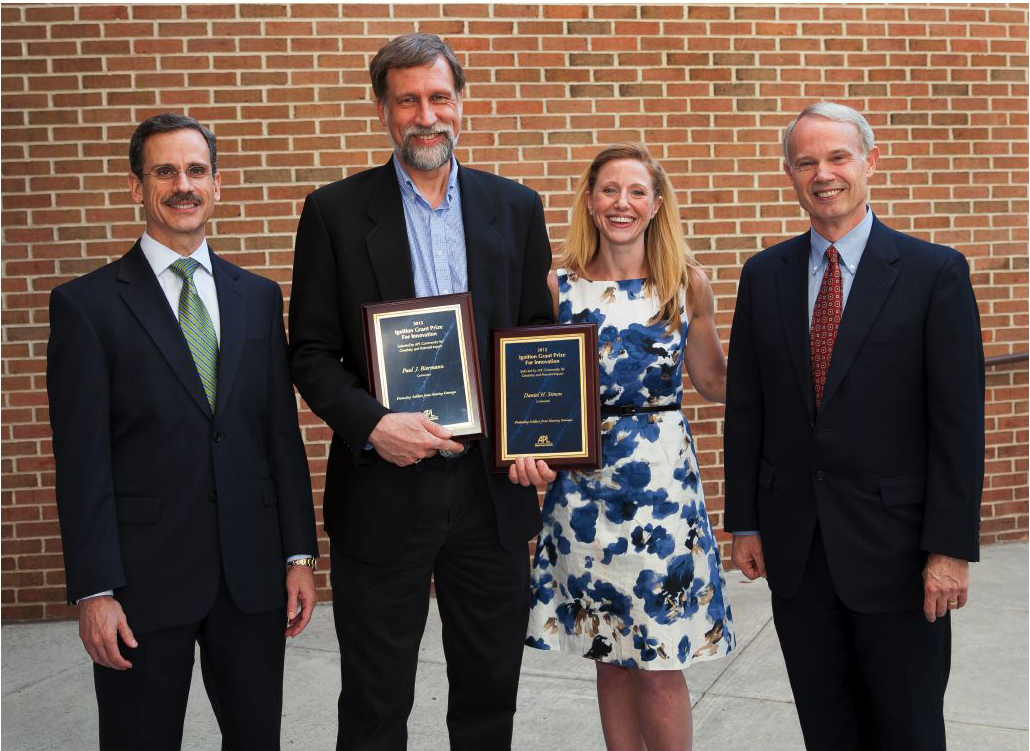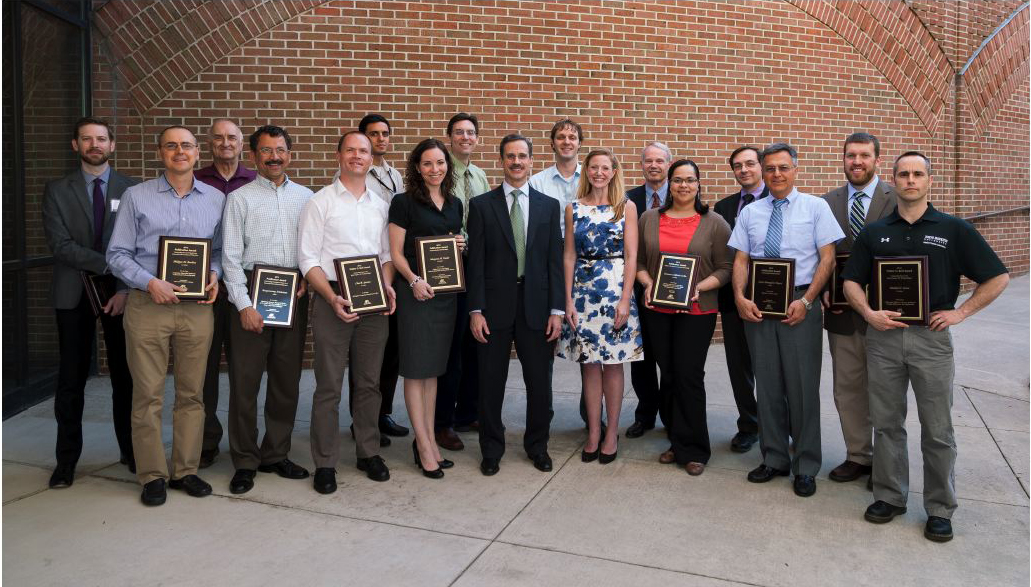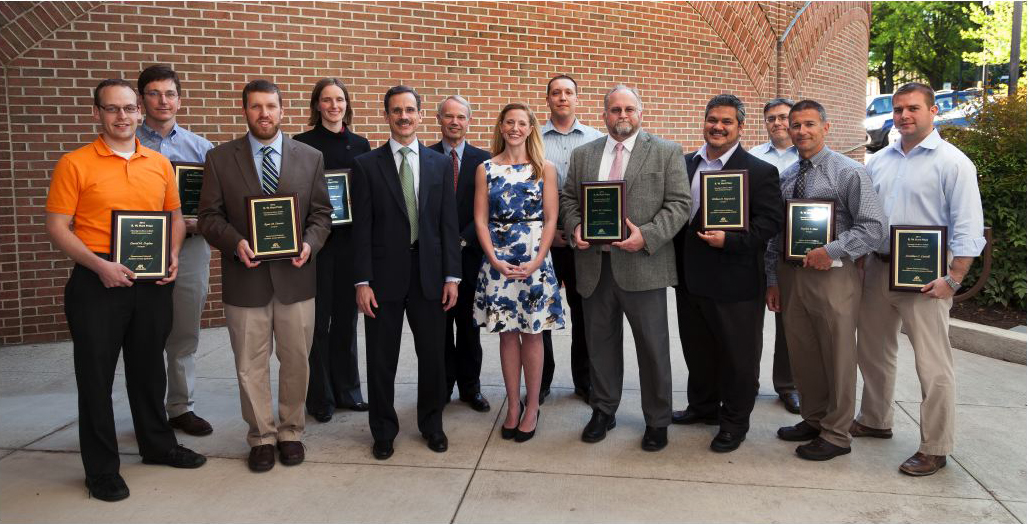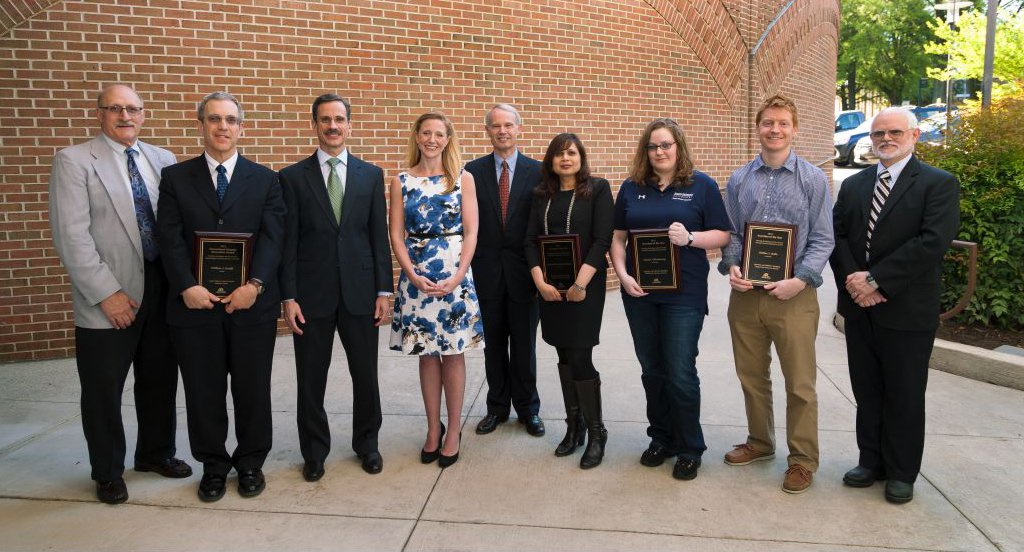Press Release
APL Recognizes Top Inventions, Researchers and Papers

Ignition Grant Prize for Innovation. Pictured left to right: APL Director Ralph Semmel, Paul Biermann, Courtney Samuels (Office of U.S. Senator Barbara Mikulski), APL Assistant Director for Science and Technology Jerry Krill
Credit: Johns Hopkins APL
The Johns Hopkins University Applied Physics Laboratory (APL) recognized its top inventions, publications and researchers from 2012 in its first spring Technical Achievement Awards ceremony, held May 1 in the Kossiakoff Center on APL’s Laurel, Md., campus.

Publication Award Winners. Pictured left to right: Unknown, Philippe M. Burlina, Anton Haug, Rengaswamy Srinivasan, Chad Sprouse, Ryan Mukherjee, Morgana Trexler, Jeffrey Maranchi, APL Director Ralph Semmel, Chad Weiler, Courtney Samuels (Office of U.S. Senator Barbara Mikulski), APL Assistant Director for Science and Technology Jerry Krill, Xiomara Calderon-Colon, Michael Dennis, Amir-Homayoon Najmi, Ryan Deacon, Michael Gross
The Invention of the Year award went to Margaret Lospinuso and her collaborators for a novel technique that creates a compressed DNA-type fingerprint of a binary that represents the various types of instructions found in its code. It then compares this fingerprint to those of known malware, exposing any similarities between the binary’s code and code in known malware. The Lab’s Government Purpose Innovation Award — which recognizes an invention that has the potential to make a major impact in the defense community, and on the nation — went to William J. Geckle for a system that can detect and locate the source of false signals generated by radar jamming devices.
“These award-winning inventions represent the best new ideas emerging from the Lab,” says Norma Lee Todd, supervisor of APL’s Office of Technology Transfer. “Inventions are a critical indicator of an organization’s innovation, and all of the inventions nominated for this honor promise to significantly impact both national security and the marketplace.”

R. W. Hart Prize for Research. Pictured left to right: David Deglau, Stergios Papadakis, Ryan Deacon, Joan Hoffmann, APL Director Ralph Semmel, APL Assistant Director for Science and Technology Jerry Krill, Courtney Samuels (Office of U.S. Senator Barbara Mikulski), Christopher Olson, Robert Chalmers, William Fitzpatrick, Robert Bamberger Jr., Stephen Carr, Jonathan Castelli
Credit: Johns Hopkins APL
A new Innovation Award, which recognizes the most creative Ignition Grant project for 2012, went to Daniel Simon and Paul Biermann for creating an inexpensive prototype to prevent hearing damage from sudden blasts. Ignition Grants are a Lab-wide initiative to encourage staff to explore and pursue innovative ideas outside of APL’s traditional processes.
The Publication Awards, selected from the technical writings of APL staff and outside collaborators, covered several categories:
Author’s First Paper in a Journal or Proceedings: Xiomara Calderon-Colon, “Structure and Properties of Collagen Vitrigel Membranes for Ocular Repair and Regeneration Applications,” Biomaterials.
Outstanding Paper in the Johns Hopkins APL Technical Digest (The Walter G. Berl Award): Jeffrey Barton, “Fundamentals of Small Unmanned Aircraft Flight”; Michael Gross, Patrick Callahan and Michael Dennis, “A Fiber Laser Photonic Frequency Synthesizer: Concept, Performance, and Applications”; Bryan Jacobs, Chad Weiler, Jeff Maranchi, Chad Sprouse, Dennis Lucarelli and Brian Rayburn, “All-Optical Computing Using the Zeno Effort.”
Outstanding Research Paper in an Externally Refereed Journal Publication: Ryan Mukherjee, Chad Sprouse, Aurelio Pinheiro, Theodore Abraham and Philippe Burlina, “Computing Myocardial Motion in 4-Dimensional Echocardiography,” Ultrasound in Medicine and Biology.
Outstanding Development Paper in an Externally Refereed Journal Publication: Rengaswamy Srinivasan, “Monitoring Dynamic Thermal Behavior of the Carbon Anode in a Lithium-Ion Cell Using a Four-Probe Technique,” Journal of Power Sources.
Outstanding Professional Books: Anton Haug, Bayesian Estimation and Tracking: A Practical Guide; Amir-Homayoon Najmi, Wavelets: A Concise Guide; Jeff Nanzer, Microwave and Millimeter Remote Sensing for Security Applications.
Outstanding Special Publication: Morgan Trexler and Ryan Deacon, “Artificial Senses and Organs: Natural Mechanisms and Biomimetic Devices,” Biomimetics: Nature-Based Innovation.
A Publication Lifetime Achievement Award also went to Keith Raney, a world-recognized expert in space-based radar design and ocean science. During his time at APL he published nearly 100 scientific articles that have been cited nearly 1,400 times.

Government Purpose Innovation Award. Pictured left to right: Howard Feldmesser, William Geckle, APL Director Ralph Semmel, Courtney Samuels (Office of U.S. Senator Barbara Mikulski), APL Assistant Director for Science and Technology Jerry Krill, Sakunthala Harshavardhana, Laura Glendenning, Nathan Reller, Bliss Carkhuff
Credit: Johns Hopkins APL
Twelve projects were nominated for the R. W. Hart Prizes for Excellence in Independent Research and Development, which honors those who make significant contributions to science and technology through projects in basic and applied research and exploratory and advanced engineering. “Nanostructured Materials: Radiation Sensing Applications,” led by Joan Hoffman, was named best research project and “Organic Persistent Intelligence, Surveillance and Reconnaissance (OPISR),” led by David Scheidt, earned the award for best development project.
Areas of Impact
The Applied Physics Laboratory, a not-for-profit division of The Johns Hopkins University, meets critical national challenges through the innovative application of science and technology. For more information, visit www.jhuapl.edu.